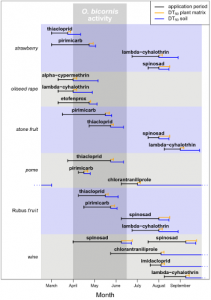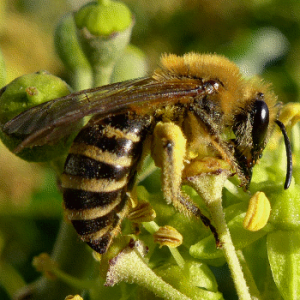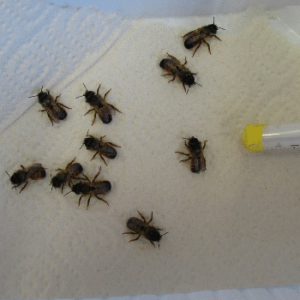Are you interested in wild bees and how agricultural pesticide use might affect them? Within the team “Community Ecology & Ecotoxicology” we offer multiple theses approaching this broad topic from different angles applying an array of methods. You may investigate various questions in a research project course (RPC) or a master thesis.
Available RPCs
Literature review and meta-analysis of the pollen diet of wild bee species and their potential oral pesticide exposure
The most likely pesticide exposure pathway of (solitary) bee larvae is dietary uptake of contaminated pollen provisions that were collected by adult females. To estimate such exposure it is necessary to assess the quantitative and qualitative larval pollen intake.
You will compile a database of species-specific pollen diet spectra and required pollen mass from scientific literature. Furthermore, you will collect pesticide application data for different cultivation systems. This will enable you to assess the probability of larval pesticide exposure and possibly even estimate exposure levels.
Literature review and meta-analysis of the potential pesticide exposure of bee species using ecological traits

Osmia bicornis flight period overlayed with recommended pesticide applications in various cultivation systems (figure from R. S. Schulz’ diploma thesis)
Wild bee species visit flowers in agricultural areas to collect nectar and pollen and might therefore be exposed to pesticides that are applied in different cultivation systems. Bee flight season and duration as well as timing of pesticide applications and half-life determine exposure probability (amongst other things).
You will extract bee parameters from a trait database of all European species and pesticide data from spraying recommendations and chemical databases. This will enable you to assess coincidence of bee flight periods and pesticide residues in and on crop plants, thus evaluating potential for exposure.
Exploratory microscopic analysis of pollinator cuticle
Bee species can be exposed to pesticides in the field by overspray or spray drift (amongst other pathways). It is usually assumed that pesticides penetrate the bee’s body by diffusion into the cuticle. However, physiological differences in cuticle structure may lead to differences in pesticide uptake through the cuticle.
You will prepare thin cuticle slices of different bee species for microscopy (phase contrast light or electron microscope) to compare cuticle structures in detail. This will enable you to identify and assess structural parameters that influence cuticle penetration (e.g. cuticle layer width). Further experiments might be relevant to determine cuticle uptake (e.g. penetration experiment).
Acute lab toxicity tests with Osmia bicornis
Acute pesticide toxicity data for wild bee species is scarce in contrast to honey bee toxicity data which is generated as part of the registration process for agricultural use. However, to adequately assess pesticide impact on bees additional species should be tested.
You will conduct acute contact lab toxicity tests with the red mason bee Osmia bicornis using an array of pesticide products that are applied in European agriculture to derive median lethal doses (48h LD50). This will enable you to investigate variability of toxicity between substances and compare toxicity endpoints of this solitary bee species to the honey bee.
Available master theses
Multi-species bee lab toxicity tests with the neonicotinoid thiacloprid
Data on interspecific sensitivity of bees is scarce except for honey bee toxicity endpoints that are generated as part of the registration process in Europe. However, to properly evaluate pesticide impact on bee communities an extensive database is needed.
You will conduct acute contact toxicity experiments with a wide array of bee species to generate median lethal doses (48h LD50) using the toxic standard dimethoate and the neonicotinoid thiacloprid. Afterwards, you will derive species sensitivity distributions (SSD) for both pesticides.
Multi-species microscopic and chemical analysis of bee cuticle to investigate pesticide entry pathways
Bee species can be exposed to pesticides in the field by overspray or spray drift (amongst other pathways). It is usually assumed that pesticides penetrate the bee’s body by diffusion into the cuticle. However, pesticides might also be taken up by spiracle openings directly reaching the trachea system. The relative importance of both pathways is actually unknown. Furthermore, interspecific physiological differences in cuticle/spiracle structure may lead to differences in pesticide uptake through the cuticle.
You will development contrast/dye methods to visualize pesticide penetration pattern in microcopic cuticle slices of different bee species for microscopy (phase contrast light or electron microscope) to investigate preferential pathways. Furthermore, you will conduct chemical analyses (HPLC-MS/MS) to quantify pesticide residues in multiple species after cuticle or spiracle exposure.
This will enable you to identify preferential pathways of pesticide uptake and compare those between species.
Pesticide exposure assessment of flowering plants in field margins
To assess the risk of in-field pesticide application for non-target pollinator populations in off-field habitats an understanding of the exposure of flowering plants in field margins is necessary. The current agricultural practice in Germany is to overspray part of the first meter of off-field habitat to ensure a 100% in-field application rate. Therefore, high pesticide doses are introduced into non-target areas. Flowers may be exposed in particular since they are generally situated above the grass canopy and might therefore collect a higher amount of pesticide residues. So far no information is available on this aspect.
You will quantify pesticide inputs to flowering plants in field margins and assess the efficiency of drift reducing measures such as edge nozzles. After conducting the field work you will be able to establish and validate a field margin exposure model for flowering plants and compare in-field to off-field exposure in different scenarios.
Are you interested?
If you are interested in doing a thesis with our team, please contact us:
Philipp Uhl (uhl@uni-landau.de) & Carsten Brühl (bruehl@uni-landau.de)
The topics above are a few rough outlines which may be adapted to your personal interests. Feel free to contribute your own ideas and research questions. Theses involving practical experiments will be conducted from spring to autumn 2018 (with prior preparations). Theoretical theses can be started earlier.


